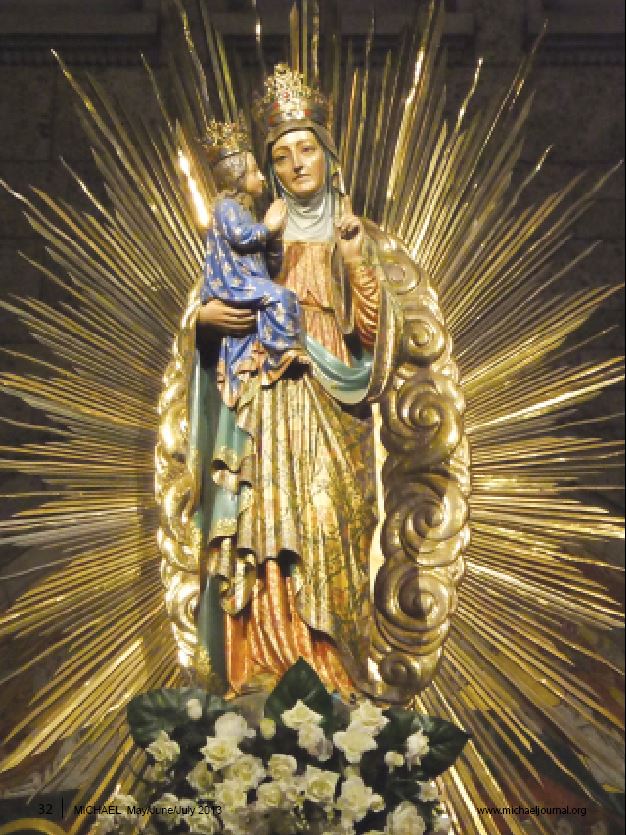 The following article was written by Louis Even, a master story teller, as he paid homage to good Saint Anne, patron of the Bretons of Britanny, France. She is also the patron saint of the province of Quebec, the one who flooded our ancestors with miracles. Many of our fathers and mothers would go to Ste. Anne de Beaupre for their honeymoon, beginning their married life together under her mantle.
The following article was written by Louis Even, a master story teller, as he paid homage to good Saint Anne, patron of the Bretons of Britanny, France. She is also the patron saint of the province of Quebec, the one who flooded our ancestors with miracles. Many of our fathers and mothers would go to Ste. Anne de Beaupre for their honeymoon, beginning their married life together under her mantle.
by Louis Even
The Gospels are silent on the life of Saint Anne. They do not even mention her name. What we can know about her earthly life come to us from tradition or private revelations. But this one consideration that Saint Anne was the mother of the Immaculate, is already enough to explain the qualities and virtues which the Christian people feel are represented by her; the universality of the cult rendered to her; and the multiplicity of the sanctuaries dedicated to her.
If the Gospel says nothing of the mother of Mary, we can still imagine the marvels for which her house must have been the theater by reading what the Gospels do tell us concerning Saint Elizabeth, the mother. of Saint John the Baptist.
An angel appeared to Zachary, Elizabeth’s husband, to announce to him that his wife would conceive and bring into the world a son who would be great before the Lord. Can we not think that an angel announced in the same way to Mary’s parents, Joachim and Anne, that Anne would conceive and bring into the world a daughter who would be greater before the Lord than all creatures, more than the angels, more than the humans? Moreover, this is what we learn from the visions of Blessed Catherine Emmerich and of Venerable Mother Mary of Agreda’s Mystical City of God.
If John the Baptist’s purification from original sin in the womb of his mother Elizabeth, filled her with joy and flooded her with a light of the Holy Ghost, acknowledging her cousin Mary as the Mother of the Messiah so waited for, is it not logical to assume from this that the conception of Mary Immaculate, without one instant nor one shadow of original sin, had thrown Anne into an even greater rapture?
Could we not say that it was a new human creation that took place in this very moment? In the terrestrial paradise, God had created Eve, who like Adam, was perfectly innocent, pure from all fault. But after the fault committed by these first parents and subsequently affecting their very nature, all of their descendants were necessarily genetically marked by this infection at the first moment of their conception; but now in the womb of Saint Anne, a child is conceived, who is as well descended from Adam and Eve after their fault. Only a special act of God could create this derogation to a natural law. A divine action in a way similar to the creative action that brought Adam and Eve out of nothing. It was not the cleansing of fault, as by Baptism, for there was no fault to be cleansed. The child conceived in Saint Anne’s womb was truly a new Eve, more pure and more perfect than the first Eve on emerging from the Creator’s hands.
Then the Holy Ghost certainly must have overcome and enlightened Saint Anne, more intensely than he will do for Saint Elizabeth at the time of the purification of John the Baptist in her womb. The angels were witnesses to the new “creation”, and it must have been like the whole of Heaven entering into Anne and Joachim’s house. The Angelic choirs, in ecstacy, must have asked themselves: “Quae est ista?” Who is this one who come forth from the descendants of Adam and who does not bear the characteristic fault attached to human nature by the sin of Adam and to all his descendants?
Father Eugene Lefebvre, Redemptorist, writes about this subject in his brochure Life of Saint Anne:
“While life continues all around in the city of Jerusalem, like nothing had happened, the universe itself is transformed in the eyes of God, by this child who has just been born. In this little girl whom Saint Anne has just brought into the world, the Lord reveals a being more pure and more holy than all the choirs of Angels: He sees in Her the Woman who soon will be the Mother of His only Son.
“The joy that Saint Anne felt when the Immaculate Virgin, whom she had just brought into the world, was presented to her, defies all description. She already vaguely guessed, from the bottom of her heart, that, thanks to the little Mary, one day it would be given to her to be the grandmother of Christ.”
 The glorification of Saint Anne on the vault of the apse of the Basilica of Ste. Anne de Beaupre. Here we see Saint Anne with Mary and Jesus. Saint Anne is presenting a fruit to Jesus, the fruit of life: a symbol of his mission as Redeemer, who came to save the world from original sin, the fruit of death. The glorification of Saint Anne on the vault of the apse of the Basilica of Ste. Anne de Beaupre. Here we see Saint Anne with Mary and Jesus. Saint Anne is presenting a fruit to Jesus, the fruit of life: a symbol of his mission as Redeemer, who came to save the world from original sin, the fruit of death. |
But let us each continue these meditations on known events. The events succeed one another in the life of Saint Anne: the Presentation of the little Mary in the Temple; the marriage of Mary to Joseph; the birth of Jesus that consecrated Anne as the grandmother of the Messiah; Anne’s joys when, at the time of her visits to Mary in Nazareth, she would take the Infant Jesus in her arms or on her knees; her joys of the services that she never failed to lovingly render to the Holy Family; her sweet death, assisted by the presence of Mary, of the divine Adolescent, and also without doubt that of Saint Joseph; the flight of her beautiful soul towards Limbo where she was going to bring good news to the just, and where, with them, she would wait for the opening of Heaven by her Grand-Son at the time of His triumphant Ascension.
We would now like to speak a bit of the glories of Saint Anne since she has been in Heaven, of the -cult that the Christians render to her, of the sanctuaries where they visit and honor her, and of the multiple graces that her heart of a grandmother obtains for those who invoke her. But since we must set a limit, we will restrict ourselves to draw attention to three high places of her cult among the hundred of the old and -of the new continent: Apt in France, Auray in Britanny, France, Beaupre in Canada.
Apt is one of the oldest cities in France, already well established when France was still then the Gaul. In the time of the Caesars, Apt was the capital of the Vulgientes, people of the valley of Durance submitted to the Roman domination. In the time of the kings and of the natural divisions of France into provinces, Apt was a city of Provence, a beautiful south-eastern province, between Dauphine at the north, the lower Rhone at the west, the border of Italy at the east and the Mediterranean sea at the south. Today, Apt is a chief town of the department of Vaucluse.
It is through Apt that Saint Anne entered into France. And through a gift of the Blessed Virgin Mary who was still alive. It is that, in the designs of God, France was to be a land of dilection of Mary. The story of Mary giving to France the gift of •the mortal remains of her mother is a beautiful story.
After the Pentecost, the preaching of the Apostles and the witnesses of those who had known Jesus and seen His miracles brought numerous Jews to the new-born Church. This inflamed considerably the obstinate civil and religious leaders in their hatred against a Messiah who had by no means responded to their plans, and who had denounced their pride, hypocrisy and their hardness of heart.
Among the particularly eloquent witnesses, there was Lazarus, risen from the dead! The Jewish leaders had some success telling the people that Jesus was not risen from the dead, and that his resurrection was a fabrication of the apostles and of some of the disciples. The great mass of the people of Judea and Galilee had not seen Jesus risen from the dead; He had appeared only to a relatively small number of persons.
But Lazarus was known and frequently seen since he had been brought back to life after four days in the grave, as he was a well-known man, and not from an obscure family. Everyone in Bethany, Jerusalem, and much beyond, knew the happening of his resurrection. And this person, risen from the dead, was not in a hurry to die again and to disappear from circulation.
The year 43 was near. Now almost ten years since His Ascension, Jesus was no longer a visible presence, but the risen Lazarus was always there. A direct witness. A bothersome witness. They had to get rid of him, and also his sisters Martha and Mary, and his sisters’ servants. Also dangerous were Mary Jacobe, mother of James and John, and Mary Salome: these women had followed Jesus straight to Calvary, they knew too much and would not consent to be silent; also Maximin, a fervent disciple of the Master and Ceddonius, the man born blind, whose cure had made so much noise in all Jerusalem. (Cf. John, Chapter 9.)
To put them to death without a valid reason could seem too revolting and be harmful to the cause of the enemies of Christ. They found another solution. To get rid of them without slaughter. All these friends of Jesus were embarked in a small boat without a sail, nor oars, nor helm, nor food, and pushed out to sea and abandoned, with a lot that could not be other than a fatal shipwreck or death from starvation. They would no longer be bothersome.
But the enemies had not reckoned with Mary, Mother of Jesus. Still living on the earth, She was already supernaturally informed and supernaturally powerful. She was about to make the plans of the enemies of Jesus serve for the promotion of the Gospel and for the execution of her own program, in full agreement with the designs of God. Mary desired to see the Gospel brought without delay to a country She loved.
To bring the Good News from Palestine to France, one must necessarily cross the Mediterranean sea. It is true that enemies of the Gospel had placed propagators of the Gospel on this sea, with a perverse design, but, already, for them, Mary would be “Star of the Sea”. She would intercede for their landing safely ashore at the foot of the hills of future France. But besides this, Mary wanted to give them, and by them to France, a remarkable gift: Mary had discreetly placed on the adrifting boat the mortal remains of Her mother, Saint Anne!
Without sail, no pilot, nor helm nor oars, the group berthed at the place since named “Les Saintes Maries de la Mer” (The Holy Marys of the Sea); and with them, the body of Saint Anne. It was February 2nd in the year 43, the same year Saint Peter arrived in Rome which would henceforth be the papal seat. It was at Saintes-Maries de la Mer that the first cross was planted and the first Mass celebrated in France.
Saint Lazarus became the first Bishop of Marseille. Saint Maximin and Ceddonius established a Bishop’s Seat at Aix. Saint Mary Magdalen almost immediately retired herself in solitude. She was the first contemplative of the Gauls, passing the last thirty years of her life in the grotto known today as Sainte-Baume. The other holy women helped these first missionaries and converted numerous fishermen, shepherds and farmers of the Bouches-du-Rhone region.
As for the remarkable relic of St. Anne, it was confided to Saint Auspicius, who brought it to Apt. Since the persecution made his martyrdom imminent, he hid the relic underground. The witnesses to this hiding of the relic also disappeared in the persecutions and no one knew anymore what had become of the mortal remains of the mother of the Mother of God. These remains stayed hidden and lost for more than 700 years. They were not rediscovered until Easter 792, by Charlemagne, who was then king of France and future emperor of the West. (See text above.)
A church dedicated to Saint Anne, built on this spot, became a frequent pilgrimage center, where numerous recognized miracles took place. In the 17th century, Anne of Austria, spouse of King Louis XIII, sent a delegation to this spot to implore from Saint Anne an heir to the crown of France. Anne of Austria attributed to Saint Anne the birth of Louis XIV. Later, she herself went to Apt with an imposing number of followers and offered rich presents: a golden statue of Saint Anne, articles set with precious stones, and a sum of 8,000 pounds to have a chapel more worthy of the remarkable relic, built in the basilica.
Several papal bulls certify the authenticity of Saint Anne’s body venerated at Apt; among these are found those of Popes Adrian, Benedict XII and Clement VII. A multitude of well ascertained miracles give additional witness to this.
An arm of this body was bestowed to Rome and conserved at the Benedictine monastery of St. Paul Outside the Walls. It is from this arm, that, at the request of Cardinal Taschereau of Quebec, Pope Leo XIII detached a piece of bone 4 inches long to be brought to Sainte-Anne de Beaupre, Canada. On the way to Canada, the relic was kept in New York City three weeks, exposed in a church that was always full, receiving the veneration of more than 250,000 pilgrims, many of these pilgrims coming from very far away. On July 26th, 1892, after a pontifical Mass, Cardinal Taschereau deposited this relic in the sanctuary of Sainte-Anne de Beaupre.
In Apt, the underground that guarded Saint Anne’s body for more than seven centuries, forms the second crypt of the actual basilica. But if Saint Anne, in coming out of Palestine, had Provence as a home, she most particularly elected, as privileged fiefs, Britanny, at the extreme west of France, and the province of Quebec, in Canada.
The most famous sanctuary of Saint Anne in Europe is that of Saint Anne of Auray, in Britanny, that is dated from the first quarter of the 17th century. It is not by a relic of her mortal body that the grandmother of Jesus is installed most especially in Auray, but by a very personal intervention of Saint Anne, well alive in Heaven, who came to tell a Breton peasant in the Breton language, that God Himself wanted in this spot a basilica consecrated to her.
It is another wonderful story but it is not a legend, nor simple tradition. It is as well established historically as the foundation of Quebec City by Champlain in 1608.
The peasant’s name was Yves Nicolazic. He did not know how to read nor write and spoke only Breton. But good Saint Anne took him as he was and prepared him, being patient during the time required for him to overcome his timidity.
 Yves Nicolazic lived in the hamlet Ker-Anna, in Plumeret, one league (3 miles, 4 km) from Auray, and 25 kilometers (16 miles) from Lorient, in the present department of Morbihan. In 1623, Nicolazic was 34 years of age. Married for twelve years, but childless, he lived with his wife Guillemette, his brother-in-law Jean Le Roux, and some domestics whom he employed, on the farm that he cultivated, but which belonged to Mr. de Kerloguen. Since his childhood, Yves Nicolazic had a great devotion to the Most Blessed Virgin Mary, loved to recite his Rosary, and was frequently seen with his Rosary in hand. As for Saint Anne, he praised her with love and often had recourse to her, calling her his “Good Patron”.
Yves Nicolazic lived in the hamlet Ker-Anna, in Plumeret, one league (3 miles, 4 km) from Auray, and 25 kilometers (16 miles) from Lorient, in the present department of Morbihan. In 1623, Nicolazic was 34 years of age. Married for twelve years, but childless, he lived with his wife Guillemette, his brother-in-law Jean Le Roux, and some domestics whom he employed, on the farm that he cultivated, but which belonged to Mr. de Kerloguen. Since his childhood, Yves Nicolazic had a great devotion to the Most Blessed Virgin Mary, loved to recite his Rosary, and was frequently seen with his Rosary in hand. As for Saint Anne, he praised her with love and often had recourse to her, calling her his “Good Patron”.
Ker-Anna means in Breton “Anne’s Village”. It was generally thought in the region, but without any proof, that there had formerly been a chapel to St. Anne, although something strange was reported about the Bocenno field which was the neighboring field of the Kerloguen farm. On a spot in this field, it was impossible to pass the plow without the yoke breaking and the oxen prancing!
One night in the beginning of August 1623, Nicolazic was thinking of his good patroness when, all of a sudden, his room was illuminated and in the midst of this brightness, he distinctly saw a hand holding a wax candle. A short vision — just enough time to say an Our Father and two Hail Marys.
Six weeks later, on a Sunday evening, he saw once again, over the Bocenno field, the brightness and the candle, but without the hand and for even a briefer time. During several consecutive months, he frequently saw the same candle shining near him. Sometimes, when he came in late after dark, the candle even accompanied him, lighting his path straight to the house. He did not know what to think of this, being moreover a bit fearful, but each time, the apparition of the candle brought him an interior and spiritual sweetness.
One summer evening, he and his brother-in-law Le Roux had gone separately and unknown to one another, to fetch their oxen in a meadow below Bocenno. There could be found a spring where they brought their oxen for watering before returning home. But suddenly the oxen refused to go forward. The two of them approached to find out the reason, when they saw a few steps from the oxen, in a light and turned towards the spring, a majestic lady holding a torch in her hand. Gripped with fright, they withdrew, then returned, but all had disappeared.
After this event, Nicolazic often saw in his home, in his garden, or near the spring, this same mysterious lady, but always silent not saying who she was.
Then came July 25, 1624, the eve of the feast of Saint Anne. Nicolazic made his way to the Capuchins in Auray for confession. He returned at dark, Rosary in hand. Passing close by a cross on his way, he suddenly saw the same mysterious Lady, with the same bearing and the same light. This time she called him by his name: “Yves Nicolazic!”, and made a sign to him to follow her, which he did, She holding the torch, and he holding his Rosary. They soon arrived at Ker-Anna and started upon the road leading to his farm. The Lady disappeared when they approached the house.
Nicolazic was particularly impressed by this longer visit of the Lady, who, nevertheless, had still not given her name. Too affected to eat, he went into his barn and stretched out on a straw bed. Since he could not sleep he took his Rosary and began to pray.
Suddenly, around eleven o’clock, he thought he heard a noise outside, as if a crowd was passing by the road next to the barn. He quickly got up and opened the door, but there was nothing, absolutely nothing in the country, everything was silent. Fear overtook him, and taking his Rosary he continued to pray to seek reassurance.
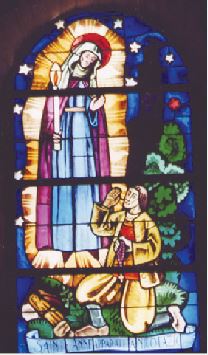 Nicolazic receives his mission
Nicolazic receives his missionSuddenly, around two o’clock, a great brightness filled the barn and, in this halo, was found the Lady, more resplendent than ever. And this time she spoke:
“Yves Nicolazic, fear no more. I am Anne, mother of Mary. Tell your parish priest that in the piece of land called Bocenno, there was at one time, even before any village was established there, a chapel dedicated to my name. It has been 924 years and six months since it was ruined. I desire that this chapel be built again as soon as possible and with care. God wills that I be honored here.”
After saying this, Saint Anne disappeared, leaving Nicolazic alone. But these words had enlightened him and put an end to his perplexities. He went to sleep at peace, his heart swollen with joy and love.
Saint Anne, herself, therefore related the precise historic fact: a chapel under her patronage had once existed there so the devotion to Saint Anne was therefore spread in Britanny at that time. The chapel had fallen into ruins 924 years and six months before July 26th, 1624, which means in January 700, ninety-two years before the discovery of the mortal remains of Saint Anne by Charlemagne, in the underground of Apt where these remains had been hidden since the apostolic times.
St. Anne had a good memory. She had loved the prayers of the Bretons gathered to honour her in Ker-Anna, more than nine centuries ago. She surely would have announced to her devotees of old, some now entered into Heaven, that she was about to make this devotion alive again with even more splendour than in the past, because this was her desire and the will of God as she had said to Nicolazic at the hour of the Matins of Saint Anne’s, 1624.
On Monday, March 3rd, 1625, his Good Patroness appeared to him with more solemnity than usual in the Bocenno field, and not only in the luminous brightness of the previous times, but also accompanied by wonderful singing seeming to come from an invisible celestial choir. Saint Anne insisted on the accomplishment of her requests, adding that the time of delay was definitely terminated. Nicolazic grew bold enough to suggest to her with simplicity and respect: “Make therefore some miracle, my Good Patroness, so that everyone will recognize your will.”
To this Saint Anne answered: “Go, confide in God and in me: you will soon see miracles in abundance, and the greatest of these will be the crowd of people who will come to honor me in this place.”
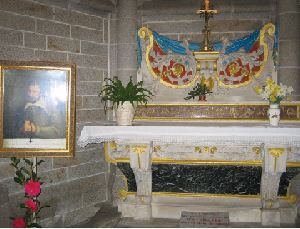 Miraculous discovery
Miraculous discoveryMarch 7th was to be a decisive day. The night before, upon rising, John Le Roux (NIcolazic’s brother-in-law) had found 12 quarts of crowns on the table in his room. It could be nothing else than a first miraculous gift for the future chapel requested by Saint Anne. Nicolazic had knotted them in his handkerchief and, with Lezulit, had gone to the rectory to show them to the parish priest. It was the curate who answered and, being skeptical, did not even want to listen to them. It was truly disappointing.However the evening of March 7th; around eleven o’clock, Saint Anne appeared to Nicolazic who, lying on his bed but not sleeping, was reciting his Rosary. She said to him:
“Yves Nicolazic, call your neighbors, as you were advised. Bring them with you to the place where the torch will guide you. You will find there the statue that will protect you against the world, which will finally know the truth of what I have promised you.”
Nicolazic rose, dressed quickly, ran to get his neighbors, among these John Le Roux, who provided himself with a good pickaxe. The group therefore followed the torch that directed them to Bocenno. Here, the candle rose three times, and disappeared into the earth. Nicolazic marked with his foot the place where the candle had penetrated. John Le Roux dug. He soon hit a piece of wood. They withdrew from the ground a statue. In the morning, after having cleaned it, one could still see traces of paint. It was a statue of Saint Anne in hard wood, damaged by its stay of several centuries in the earth.
This was the unquestionable sign of the truth of the apparitions of Saint Anne to Nicolazic and of her request for a chapel. In light of the good faith of the seer, and the ever growing crowd of pilgrims, Bishop De Romadec finally granted permission to build the chapel. The first stone was blessed on July 26, 1625, and the first Mass celebrated on the spot by the parish priest Dom Renoue, in front of an immense crowd.
It was the peasant without schooling, Yves Nicolazic, who animated the construction work: becoming the contractor, the treasurer, even the alms-collector when the offerings of the pilgrims were insufficient; the organizer of transports of stones and other materials provided by the local inhabitants; the general superviser, introducing modifications to the architect’s plans when he did not find them grandiose enough. Yves Nicolazic fulfilled this myriad of responsibilities without ever having the controllers from the Bishop’s house detect a single error in the administration.
Endless lines of transport carts followed each other on the roads leading to Ker-Anna; labourers from everywhere worked on the site, but there was neither confusion nor accidents, and the volunteers always returned to their homes happy to have done their labour of love.
The Carmelites arrived in 1628, organizing the pilgrimages with great beauty and dignity. Fulfilling what Saint Anne had announced to Nicolazic, the pilgrims came from all of Britanny, and even from farther, in ever growing number. The constructions progressed, and the modest Ker-Anna of the days gone by became for all Saint Anne of Auray, or even more simply Saint Anne.
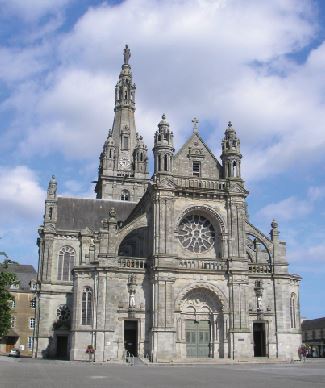 Present basilica of St. Anne d'Auray Present basilica of St. Anne d'Auray |
When he had accomplished the mission that Saint Anne had confided to him, Yves Nicolazic wanted to enter into obscurity and to avoid the admiration that the pilgrims showered on him. Indeed, everyone sought to approach him, to hear from his mouth the recital of the apparitions of Saint Anne, and to recommend themselves to his prayers. He therefore left Ker-Anna and retired on a land that he possessed in Plumeret, to once more take up the life of a simple farming peasant, with his family that now included two sons. He had, until his death, the consolation of an annual apparition of his Good Patroness, as July 26th approached.
Nicolazic had always expressed the desire of being buried on the very spot where the statue had been extracted from the Bocenno field. When he fell sick, the Carmelite guardians of the sanctuary had him transported to their convent. It is in a room of this Convent that he died. A little while before his final agony, his face radiated with joy and he held his eyes fixed on something that was invisible to the other persons present. His confessor asked him what he was looking at in this way. He answered in a clear voice: «I see the Holy Virgin and Saint Anne, my good patroness». It was May 13th, 1645. The servant of Saint Anne was buried, according to his desire, under the crypt of the basilica erected on the Bocenno field.
The figure of Yves Nicolazic effaces itself in the shadow of that of Saint Anne to whom the devotion was constantly increasing, but he remains inseparable with the origin of this splendor. Steps were made and approved in Rome in view of a possible future beatification. The author where we borrow this from, Father J. Corniquel, remarks on this subject: “We are waiting with fervor and serenity for what the Church will decide on this subject, but also with a very great hope. The day when he will be canonised, in Bretagne, in France, in the world, the peasants and fathers of families will be honored.”
Pilgrimages, Masses, processions, group or private devotions have continued without interruption for nearly three and a half centuries to this piece of Breton land chosen by Saint Anne, and the good grandmother of Jesus has not ceased to distribute a superabundance of her favours. The chapel has seen its walls covered with ex-votos (commemorative plaques for favours received). And how many other silent thanksgivings were lifted there towards the great benefactress is beyond our human knowledge.
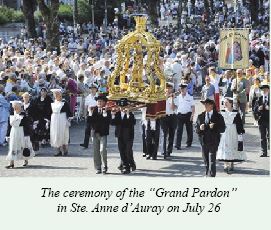 During the years of the disastrous French revolution, the pilgrimages were even more intense and more fervent than ever. When the days became too dangerous for the priests’ lives, the faithful themselves organised their processions, way of the cross, and their common prayers. In 1794, while the Terror was still reigning, a police report recorded that “the numerous gathering that fanaticism still caused at the place of Saint Anne. This cannot be extinguished without stopping the pilgrimages that are normally made to the chapel of Saint Anne.” And orders were given to accomplish exactly that.
During the years of the disastrous French revolution, the pilgrimages were even more intense and more fervent than ever. When the days became too dangerous for the priests’ lives, the faithful themselves organised their processions, way of the cross, and their common prayers. In 1794, while the Terror was still reigning, a police report recorded that “the numerous gathering that fanaticism still caused at the place of Saint Anne. This cannot be extinguished without stopping the pilgrimages that are normally made to the chapel of Saint Anne.” And orders were given to accomplish exactly that.
After the torment, there was little left of the grounds but ruins, and the debris of statues. The antique wood statue, that had been miraculously rediscovered in the Bocenno land, was itself put to the flames. But the fervor and love of the Bretons for their great patroness had remained alive, and the domain of Saint Anne was quickly raised from the plunders of the godless, and with even more splendor than before. In 1825, a new statue replaced the venerated statue burnt by the revolutionaries. In the pedestal of this new statue, they enshrined a fragment of the miraculous statue that the flames had not totally consumed.
The Carmelites, expelled by the revolution, did not return to their convent of Saint Anne, but the Bishop of Vannes had previously established there a small seminary, so the sanctuary had some priests from the teaching staff and a beautiful choir of seminarians for the liturgical offices.
The history of the restored sanctuary is distinguished by some particularly solemn dates. Among these, 1868, when a beautiful basilica, as big as a cathedral, took the place of the old chapel, now too small, and the statue of Saint Anne received the honours of coronation.
Not a single Breton, if he had the possibility, would want to spend his life without going, at least once, on a pilgrimage to Sainte-Anne of Auray. As wrote Brizeux, a Breton poet of the 19th century, born at a distance of 16 miles (25 km) from the domain of Saint Anne:
It is our mother to all; dead or alive, they say,
To Saint Anne of Auray must all Bretons go.
 From Britanny to Canada
From Britanny to CanadaLet us now go to the other great place where Saint Anne draws crowds and multiplies her generosities, that of Sainte-Anne de Beaupre, in the Canadian province of Quebec whose origin closely followed that of Britanny.
Some 30 years after the laying of the first stone at the Breton sanctuary of Auray, there was a chapel dedicated to Saint Anne in Canada (then called New France), on the north shore of the St. Lawrence River.From, a, where the favours obtained from the Saint were released from the beginning which was to become a «tide of pilgrims», to use the expression of the Redemptorist Father Eugene Lefebvre, in his brochure «Land of Miracles».
Beaupre and Auray would even be, in a certain way, two links of the same chain, between which, by the goodness and power of Saint Anne, the Atlantic served more of a joint than of separation. As a matter of fact, for lack of the written document, there is tradition which is very reliable in a country, still young. One reads in the brochure of Father Lefebvre:
«According to tradition, some Breton sailors landed at Beaupre, after having been miraculously saved from shipwreck by the good Saint Anne.
«During the storm, they had made a vow to build a chapel wherever they would touch ground. They therefore made haste to realise their promise. This was the first sanctuary erected in Beaupre in honour of Saint Anne.
«In their distress, these Bretons had invoked their Saint Anne of Auray. Their prayers answered, they set on the French land of America a Saint Anne of Beaupre, who was to make of this blessed place a «land of miracles».
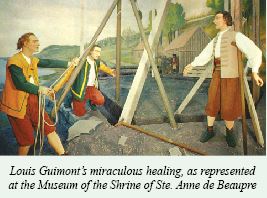 First parish church
First parish churchThis took place before 1658. The small chapel, built after the vow made by the sailors, was without doubt but a modest oratory for private devotion, and not a parish church.
It was in 1658 that the families established on this spot of the hill of Beaupre, which was then called Petit Cap, made the necessary steps to build themselves a parish church and to obtain a resident priest. Up till then, they depended on the parish priest of Château-Richer. A notarial act of March 8th, 1658 made the gift, by Etienne Lessard, of land for purposes of worship. On the 13th of this same month, the work begun and went briskly.
This first parish church, erected too close to shore, had to be brought back a bit farther because of the high tides of spring. It was dedicated to Saint Anne and opened for devotion in 1662.
The miraculous statue, at whose feet hundreds of thousand pilgrims have come to pray, was likely brought to Saint Anne Church by Blessed Francois de Laval, first Bishop of Quebec (and of Canada), at the time of his visit to this church in February 1662. He had arrived in Quebec in 1659.
At the time of another visit, March 12th, 1670, the same holy Bishop gave to the sanctuary the first relic of Saint Anne; a fragment of one of the fingers of the Saint, taken from the great relic of Apt. We have said above how a much greater relic, taken from the arm of Saint Anne, was obtained by Cardinal Taschereau and delivered by him in the same sanctuary on July 26th, 1892.

But the good Saint Anne did not wait for these relics to pour out her favours in her Canadian sanctuary of Sainte-Anne de Beaupre. Since 1662, the cures, conversions and other favours had been pouring from the sanctuary. Already, at the time of the foundation of the church, the Saint had cured a crippled man, Louis Guimont, when despite pain and misery, he managed to deposit three small stones. However it was especially after the installation of the “miraculous” statue in February 1662 that the miracles followed one another in litany. It is exactly for this reason that the statue is called miraculous.
As early as September 30th, 1665, Blessed Mary of the Incarnation, foundress of the Ursuline Convent of Quebec, wrote in a letter:
“At a distance of seven leagues from here, there is a market town called Petit Cap, where there is a church of Saint Anne, in which Our Lord makes great wonders in favour of this holy mother of the Most Blessed Virgin. We see the crippled walk, the blind see, and the sick of whatever sickness it may be recover health.»
Even before the construction of the first sanctuary, Saint Anne, as we have seen, showed herself the helper of sailors. She repeated several times this same service. As early as 1662, three Canadian travelers, Mr. de la Martiniere, Pierre le Gascon and a man named Leguille, were about to perish in a storm at Cap Tourmente after their boat turned over. They therefore made a vow to Saint Anne. Hanging on to a small piece of wreckage, they struggled for 24 hours against the furious waves. The next morning, they were found half dead on the shore, close to a house.
This incident caused considerable stir in the whole colony, and even beyond. Fifteen other salvages attributed to the good Saint Anne have been recorded. The Saint was always much invoked by sailors. The famous Le Moyne of Iberville, whose exploits at the service of New France extended from Louisiana to Newfoundland and to Hudson Bay had a great devotion to the good Saint Anne; two ex-votos from him are at the sanctuary. When boats used the north channel, between the Island of Orleans and the river bank of Beaupre, they would fire the canon in salute to Saint Anne, when passing by her sanctuary.
In 1667, Father Morel, in charge of the sanctuary, was already publishing a collection of the miracles obtained by the good Saint Anne. He also noted the numerous conversions to which he had been witness, adding that “these favours passing between God and the soul, in the secret of the heart, will not be well known but in eternity”.
The petitions to the good Saint Anne continued in the course of the past three centuries. Of course, each request does not always apparently obtain satisfaction, but Cardinal Mauricfe Roy, a former Archbishop of Quebec City, wrote: “Many have come to implore their cure at the foot of the miraculous statue. Several were answered. The greatest number returned to their homes with their sicknesses and infirmities. But often, these last were the great privileged of Saint Anne, for it is in the souls that God makes His greatest miracles”.
The family or individual pilgrimages started in 1658. We have seen group pilgrimages being organised from 1663 onwards. These pilgrimages become larger and more numerous. The stream continues today and brings pilgrims from the whole of America and abroad.A report covering the three centuries of 1660 to 1960 estimated at 25 million the number of men and women coming from all parts of the world to the little village of Sainte-Anne de Beaupre, up to one million a year in some years with over 400 organized groups, more than the days of the year. In these same years, more than 18,000 Masses and 400,000 Communions have been celebrated per year. In the single year 1958, more than two million pilgrims came to Sainte-Anne de Beaupre.
Devotion to Saint Anne expanded in Canada and throughout the whole continent within which we find many other sanctuaries and churches dedicated to Saint Anne. However, the sanctuary by Beaupre hill remains the greatest center of attraction. The 700,000 French Canadians, emigrated to the United States during the 19th century, carried her renown into this great republic. In 1892, during the time the relic stayed in New York City, 250,000 Americans came to venerate it in three weeks. The stream of pilgrims grew to such a point that it was necessary to have ten policemen on duty to guide the circulation at the entry and inside the church where the relic was exposed.
 Successive sanctuaries
Successive sanctuariesFor all pilgrimage sites, an increase in the frequency of pilgrimages and the number of participants calls for enlargements of the sanctuaries.
At Sainte-Anne de Beaupre, as early as 1676, the sanctuary of 1661 had become too small and moreover threatened to collapse. Under the prompting of Bishop de Laval, it was undertaken to replace it with a more spacious church constructed in stone. This new church measured 80 feet long and 28 feet wide, which was judged large, when compared to the previous one.
Restored for this first time in 1686, it also became too small, and in 1694 it was again enlarged by 20 feet. A century later, in 1784, it was almost entirely rebuilt, which served for almost another century, until 1876.
As early as 1872, it was decided to build a real basilica, which was opened for worship in October 1876. The rush of pilgrims continued and increased and in 1882, it was necessary to enlarge it by adding more aisles; a second time in 1886, by lengthening it by 40 feet. Two steeples, with an imposing statue of Saint Anne between them, were also added at this time.
On March 29th, 1922, the faithful devotees of Saint Anne and the whole country were plunged into sadness on hearing of the total destruction by fire of the basilica, the monastery and the residence of the young Redemptorists. The only thing that remained, like a sign of hope after the calamity was the statue dominating the front of the sanctuary.
The basilica was rebuilt to great dimensions: 325 feet long by 200 feet wide and 300 feet high to the foot of the cross. The interior: 5 naves, 20 radiant chapels, and 24 confessionals. The sculptures found inside and in the vestibule are the works of Canadian artists. The stained glass windows come from Paris.
As long as faith and piety will remain in Canada, its sanctuary of Beaupre will go through all the vicissitudes that may afflict it, coming from either man or the elements.
In 1877, 40,000 pilgrims came to the sanctuary of Beaupre. The three secular priests in charge of the parish were truly no longer able to accomplish the task. Upon their requests, Archbishop Taschereau of Quebec decided to confide this work to a religious community. He made a call to the Redemptorist General, who was eager to accept the invitation. Since 1878, the Redemptorists therefore guard the sanctuary and at the same time look after the parish and the pilgrims.
Two years before, on May 7th, 1876, at the request of Archbishop Taschereau, Pope Pius IX had proclaimed Saint Anne the patron of the ecclesiastical and civil province of Quebec.
As regards patron saints: Saint Joseph is the first patron of the whole of Canada; Saint Anne is the patron of the province of Quebec, whose population is for the great majority Catholic and from the French nationality; and Saint John the Baptist is the patron of the French Canadians, wherever they may be.
Comments (1)
MARIA RITA RICCIARDI
VORREI TANTO COMUNICARE CON P. MICHELE RODRIGUE E COME POSSO FARE?
CHE DIO LO BENEDICA E BENEDICA TUTTA LA COMUNITA' A LUI AFFIDATA DA DIO NOSTRO PADRE
MARIA RITA
reply